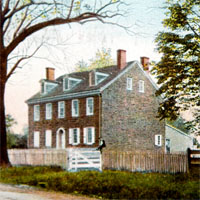Ghosts on a Narberth Corner
The southeast corner of Forrest and Windsor carries a lot of significance in our history. Here our first Welsh pioneer built his home in 1690. Here in 1891 Narberth's first mayor settled. Here on this corner a new Borough Hall was planned in 1949.
A condensed version of this article was published in the Summer 2021 Narberth Borough newsletter.
Edward ap Rees (later anglicized as "Price") stepped off the boat from England in the summer of 1682, deed from William Penn in hand. He felled the forest (or took advantage of land already cleared by the indigenous Lenape) and on this spot in 1690 built "a small severe stone dwelling a story and a half high…in those pioneer days a structure demanding respect". From his holdings, he donated a parcel to build Merion Meeting House. Over time, a barn, orchard, mill pond and meadow joined the house between present-day Dudley and Grayling.
Click the farmstead's features to read descriptions.
Ghosts on a Narberth Map
The features of the Edward ap Rees farmstead are mapped based on their description in Narberth's Historical Prelude , written by Carden F. Warner in 1905. Warner's family was among "original [1887-88] purchasers of lots in Narberth Park or vicinity", at 214 N. Essex, so it's possible that then 6-year-old Carden knew the old buildings. Click the farmstead's features to read Warner's descriptions of each. Although Warner locates its features with reference to modern streets and addresses, they must be approximately situated unless and until more information comes to light.

In addition, "the creek just north of Haverford avenue", in which stood a large water-wheel, is positioned as the stream channeled under the railroad embankment opposite 102 Dudley Ave. Given that the N. Wynnewood Avenue train tunnel predates (1879) the demolition of the Price farmstead, the embankment may have been built up over this already existing feature.
A. H. Mueller's house, on the other hand, is derived from a site plan for 117 Forrest undoubtedly prepared by Mueller, the atlas publisher, himself.
The Price farmhouse: “it had to go”
Ironically, it was Price's great-great-grandson's town-building plans that doomed the 200-year-old house. Edward Rees Price's sale of large lots from his neighboring estate helped kick off the suburbanization of Lower Merion. This corner had passed out of Price hands by 1838, and in 1887 was sold to the Real Estate Investment Co., which wasted no time in laying out streets and starting construction. Their July 28, 1888 ad in the Philadelphia Record faux-apologized "We are very sorry that we are compelled to destroy this old land-mark, but, as usual, it stands in the centre of one of the avenues and it had to go."
The Muellers’ pretty residence
Not three years later, August H. Mueller moved out of Philadelphia into a "pretty residence of stone and shingle on the corner of Forest and Windsor Avenues, with its picturesque dormer-windows and gables and piazza, surrounded by a green hedge." He gave it the fanciful latinesque name Romar Florem. A contemporary map shows that the Muellers raised chickens, planted roses, and built a playhouse for their four children who grew up at 117 Forrest.

Mueller headed the first Narberth Civic Association's ultimately successful effort to incorporate as a borough and on the third Tuesday in February 1895, his grateful neighbors elected him, at 37, Narberth's first Burgess. Mueller's proud signature and title ratifies the great incorporation map, the first of the new borough, which hangs in Council Chambers. He stepped away from local politics after a single two-year term to concentrate on his map publishing business and over the next 25 years published four editions of beautifully detailed, hand-colored Main Line property atlases, today the heart of The Narberth History Map.


The three Mueller daughters lived at 117 Forrest into the 1940s. The burgess's pretty residence was purchased by the Borough and demolished, after standing 58 years, in anticipation of "a site for a new borough hall, fire house and community building." But "the project proved to be too costly and was abandoned." Thereafter the borough imagined nothing better there than a parking lot, so sold it in 1952. It lay vacant for 10 years, when the office building at 230 Windsor that we see today was built…with a parking lot.
Perhaps it's not so unremarkable, this corner. Pause the next time you stroll by. Do you detect the scent of roses, catch the creak of a mill wheel or the cluck of chickens? You've encountered ghosts of Narberth history.
References
"The Price Plantation" in Carden Warner, Narberth's Historical Prelude (1905). "Mr. Sharpless", whose diary Warner credits for his descriptions of the Price farmstead, may be his contemporary Alfred Davis Sharples (1844–1919), grandson of Stephen Paschal, who purchased the property from the Price family in 1838 and gave it to his mother Ann Price Jackson. The Sharples Family Papers, including "a farm diary", are preserved at The Chester County History Center. Return
Samuel F. Hotchkin, Rural Pennsylvania in the Vicinity of Philadelphia (Philadelphia, G.W. Jacobs & Company, 1897), page 81 Return
Borough Business 1951 (PDF), page 7. Return
Updated February 15, 2025.






